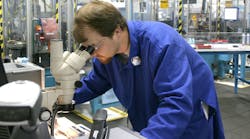Employee engagement. It's a people thing and clearly a proposition many companies have difficulty with, if a recent Gallup poll tells an accurate tale. According to the organization's data, a mere 32% of U.S. employees were engaged in 2015, a percentage that has remained fairly static since 2000.
It matters. Gallup says its extensive research shows that engagement is strongly connected to business outcomes like productivity and profitability. Data collected from the IndustryWeek Best Plants suggest the same.
The polling organization also suggested companies approach employee engagement as an "ongoing human capital strategy," factoring in elements from leadership accountability and manager education to employee development opportunities.
What it doesn't mention is technology. Can it play a role?
Few would posit that technology is going to create an engaged workforce. Perhaps not, but it can assist, as the following examples show. Manufacturers like Polaris and Autoliv recognize that engaging the minds and talents of their employees is a powerful path to success. Technology provides a tool to help smooth that path.
Polaris Industries' Innovation Culture
Have you seen the Polaris Slingshot? If you have, surely you did a double take because the three-wheeled motorcycle – which from the front appears to be a car -- stands out in a crowd. The dramatic roadster, introduced in mid-2014, looks like something a superhero would pilot, and no wonder: It's specifically designed to "deliver head-turning exhilaration," a company vice president said at the time of the Slingshot's initial announcement.
Early results in the marketplace look good for the new product. In comments about its 2015 annual results, Medina, Minn.-based Polaris Industries reported that sales of the Slingshot significantly exceeded expectations in its first full year on the market – and in what was admittedly a difficult year for the powersports manufacturer.
The Slingshot is a result of a well-nurtured company culture of innovation. Not only does Polaris Industries' believe everyone and anyone of its employees can contribute to imagining its next breakthrough innovation, but also it actively encourages that effort.
"We always want our employees to be thinking of the next big thing," says Joseph Laurin, a 27-year Polaris veteran and manager of Visioneering, Polaris' name for employee innovation. "Everyone has a specific skill set. It could be knowledge, it could be experience, it could be hands-on. Basically, as people come in the door, we encourage them to get involved in those ideas, and concepts and developing things."
That's how the Slingshot got its start, bubbling up via the Visioneering process. "Our employees are customers too, so [they] have good perspectives on the market future," Laurin notes.
Polaris also spurs idea generation with periodic innovation challenges, including its biggest, the annual invention day contest. The Sportsman Ace off-road vehicle is the biggest idea to emerge from this challenge; others include the Ranger EV (electric vehicle) as well as a low-inertia crankshaft used in several of Polaris' Axys snowmobiles.
Anyone can submit ideas, from the president to a production line employee.
So where is the technology assist in all of this? While the company's employee innovation effort is clearly people-inspired, an innovation management software solution provides the means for Polaris to manage the process. The company introduced Spigit in 2010 to automate what largely had been a manual process until then. Visioneering got its start in 2004.
We always want our employees to be thinking of the next big thing."— Joseph Laurin, manager of Visioneering at Polaris Industries
Fundamentally, Spigit is about crowdsourcing, or capturing ideas from large groups of people—the internal workforce, in the case of Polaris. "Nobody is smarter than all of your employees put together," notes Spigit chief marketing office Amy Millard. Another user of the technology, Unilever, employs it to engage with consumers and entrepreneurs to crowdsource solutions to sustainability issues.
The solution does more than simply capture data, however. It sorts the data rapidly using algorithms, and invites the "crowd" in to vote ideas up or down, and comment and view trends. Experts, too, may get involved to determine the viability of the idea. Ultimately the best ideas graduate to the top of the funnel, explains Laurin.
On a related note, the Visioneering manager pointed out the importance of providing closure on ideas—and Spigit helps there as well. "People will continue to be very cooperative as long as there is closure. Sometimes people have ideas on things we've already done, but they don’t realize it – a 'Hey, Bob, you had a great idea on this ATV tire. It's either in development or we tried that three years ago and we had issues.' We always try to bring closure to everything so people understand and don’t think their ideas are in vain or going nowhere," Laurin says.
The Spigit software has proven popular within Polaris. While it was initially purchased and used solely by the Visioneering group for innovation, other parts of the organization have requested and used it to issue challenges and crowdsource employee-generated improvement ideas. Examples include companywide challenges for cost-reduction ideas that generated significant response. Also, the information system team and safety teams have issued challenges via Spigit, and it has been used as well to improve Polaris clothing and generate new accessory ideas.
Moreover, Laurin adds, "as Polaris grows, [the challenges] help get all the sites engaged."
All that said, Spigit's Millard also noted the software's limitations. "We can't provide a culture that cares about innovation and improvement," she says. "If you don't believe that employees can help you, then no technology" is going to make that happen.
Autoliv Builds a Problem-Solving Workforce
Bob Argyle remembers the experience of working with Toyota in the late 1990s to improve plant efficiency and become a better supplier to the automotive OEM. At that time he worked in Utah for Autoliv, an automotive safety products company that makes seatbelts and airbags, among a host of other products. The Tier 1 supplier already had been practicing lean manufacturing for a while by then, but learning from Toyota was quite different than learning from lean consultants. Toyota did not prescribe solutions, Argyle said.
"Basically, they taught us the Toyota Production System. Their whole premise is based on kaizen. You've got to make your problems visible because that's where the waste is," Argyle says. "It's all about the elimination of waste. And the way you eliminate waste is you make your problems visible, and then you engage your employees in solving those problems."
As part of the learning experience, Argyle also made several trips to Toyota in Japan, where he saw impressive andon systems—which signal when a production line needs help--"that connected to just about everything," and watched as Toyota repaired in 15 to 20 minutes a piece of equipment that would have taken Autoliv hours. Why the difference? The Toyota facility had an extremely good notification protocol, plus "they had a procedure to follow because they had good downtime data," Argyle says.
Autoliv was intrigued but couldn't mimic Toyota's andon system – it was too hardware dependent and expensive, Argyle said. However, it could and did improve upon the system the two Utah facilities had been using, first with an Access database, then using a whiteboard and magnets, and finally graduating to a software solution. When they showed the solution to their Toyota mentor, his response was "if it solves your problem and can reduce waste, then it's the right thing to do."
That was then. Today Autoliv is widely recognized for its lean expertise—to the point where the automotive supplier also operates Autoliv Lean Consulting, which helps clients implement lean. The technology, first imagined at Autoliv those many years ago, became the foundation technology for a stand-alone company, Leading2Lean, that emerged in 2010. Argyle is now the chief customer officer for the company, which touts its cloud-based, real-time visual management solutions.
You might say that developing a problem-solving culture was baked into the solution right from the start.
Global Implementation Underway
Autoliv's Curtis Bird is a busy man. The project manager is engaged in Autoliv's global installation of Leading2Lean's Dispatch solution, an implementation that began about a year and a half ago, after the manufacturer's executive team decided it wanted a global solution for andon. While the Leading2Lean technology had been used in Autoliv's Americas facilities for a long time, other regions had been using other systems.
The Leading2Lean solution is currently in 56 Autoliv sites.
Like Argyle, Bird was involved in Autoliv's Utah facilities' early efforts to build a better andon system. He says the visibility provided by the Leading2Lean solution, as well as the detailed data it provides, promotes accountability and problem-solving, as well as teamwork among the workforce.
Everyone is involved in the system and touches it daily, from the operators to the maintenance personnel to the material logistics team. "They touch it daily and they work with one another to keep the lines running, and so it promotes teamwork," Bird says. "This is involving everybody, not just the four Six Sigma belts [for example] in your plant."
Bird described an example of Autoliv problem-solving in action, with a software assist. Every Autoliv team has goals to achieve, and for this particular team one of the goals was to reduce the costs of spares, Bird explained. "When you … check out a spare part [in the system] and you tie it to the equipment, it gives you the cost of the spare part. [Our] maintenance guy looked at the part, which is a simple-made piece tool that we paid over $100 for. He brought it up with the team," asking if they realized how much Autoliv was paying for a simple part that is changed every 100,000 cycles on the machine.
That's a simple example of someone who saw the data, challenged it and then came up with a better solution."— Curtis Bird, Autoliv project manager
The maintenance employee then took the next step, Bird said. He pulled up a print of the piece, opined that the company was paying a lot of money for something that easily could be made out of key stock instead of milling it down. Moreover, he came up with a method to double the life of the part.
"That's a simple example of someone who saw the data, challenged it and then came up with a better solution," Bird says.
The software also has been used for employee reviews and in logistics and quality.
The Autoliv project manager shared several results achieved by the first three plants in Utah that implemented the Leading2Lean solution. Over an approximately three-year period, they achieved: 75% reduction in maintenance and spare component costs; tripled throughput of work order completion; 60% improvement to uptime; 95% reduction in scrap costs; and 70% reduction in inventory costs.
"I think people, once they start getting involved, helping with maintaining their equipment, solving problems on the floor … they feel more like they have accomplished something better than just coming to work, checking their brain at the door, going through the motions and then going home," Bird says.
While Autoliv has a strong history in lean, Bird added that he believes the software solution can help to shape a lean culture in facilities that do not already have a strong foundation in lean. That said, he adds that strong leader support will deliver better outcomes. It's an observation that any manufacturer should take to heart.







